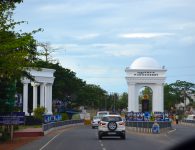Today, we traveled to the ancient temple towns of Madurai and Thanjavur. We visited the historic Hindu Meenakshi temple, as well as the Brihadeeswara temple, which is an outstanding example of the Chola architecture, under the reign of King Raja Raja I who lived between 985 and 1012 AD.
We also visited a Flower Market, and drove through small towns and captured the local deities in various forms and colors.
Origin: Madurai, Tamil Nadu
Destination: Pondicherry, Union Territory of Puducherry
Distance Covered: 335 Kms
States Covered: Tamil Nadu, Union Territory of Puducherry
The Meenakshi Temple Madurai is dedicated to Parvati, known as Meenakshi, and her consort, Shiva, here named Sundareswarar. The temple forms the heart and lifeline of the 2,500 year old city[5] of Madurai and is a significant symbol for the Tamil people, mentioned since antiquity in Tamil literature though the present structure was built between 1623 and 1655.
The Madurai Flower Market. From this flower market, many varieties of flowers especially jasmine are exported to other parts of India as well as to countries like Germany, America and Italy. The jasmine of Madurai is at the top of the list because of its unique fragrance that is not found anywhere else. In Madurai, the jasmine flower is known as the Madurai malli. Though jasmine is the most popular flower in the flower market, other varieties of flowers are also available in the flower market of Madurai.
For the jasmine and the rose, the Madurai flower market has also received an international recognition as both of these flowers are extensively used in the fragrance industry. The fashion house of Dior visits the Madurai Flower Market each year just to get motivated. It also uses these fragrances in its perfume creations.
The Tirumayam Fort: The Thirumayam Fort is a 40-acre wide fortress in the town of Thirumayam in Pudukkottai-Karaikudi Highway. It was constructed by Vijaya Raghunatha Sethupathi, the Raja of Ramnad in 1687. Later the fort was handed over to his brother in law Raghunatha Raya Tondaiman. The fort has been extensively renovated by Archaeological Survey of India in 2012.
The Tirumayam Temple: The Vishnu temple is located on the foot of the hill; it is much a much-venerated temple and is considered second in importance only to the temple at Srirangam. It contains one of the largest Anantasayi group icons in India. Anantasayi groups have Vishnu reclining on Anantha (Seshanaaga) as the central figure. The Vishnu temple contains an octagonal sacred tank called ‘Satya-pushkarani’
Note: Pondicherry, or Puducherry was the only Union Territory we touched on this drive. The City of Pondicherry has recorded history after the advent of the Colonial Powers like the Dutch, Portuguese, English and the French. However, nearby places like Arikamedu, Ariyankuppam, Kakayanthoppe, Villianur, Bahur which were annexed by the French East India Company over a period of time, and which became the Union Territory of Pondicherry after India’s independence, have history predating the Colonial History.




No comments